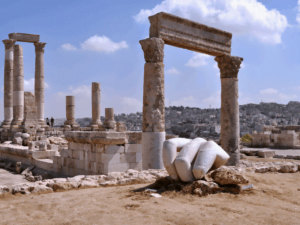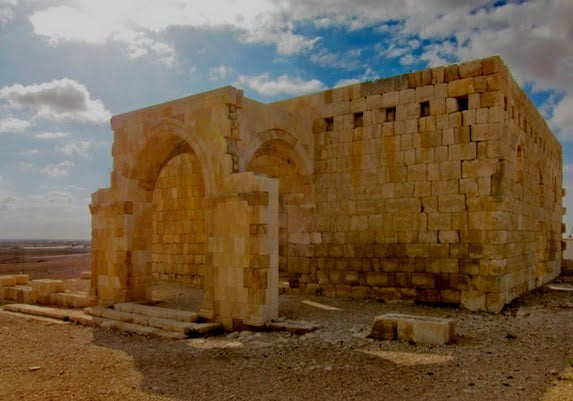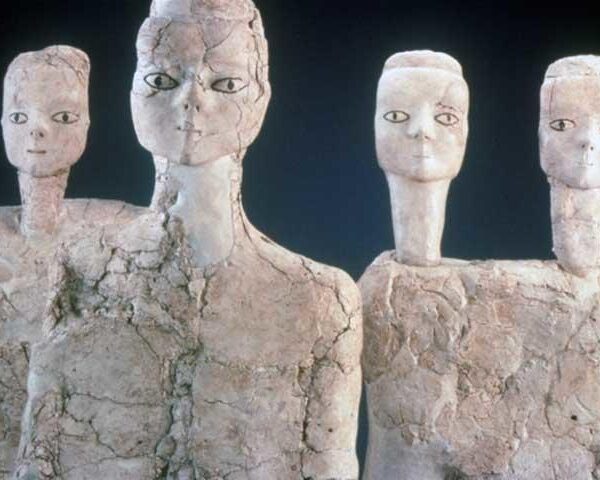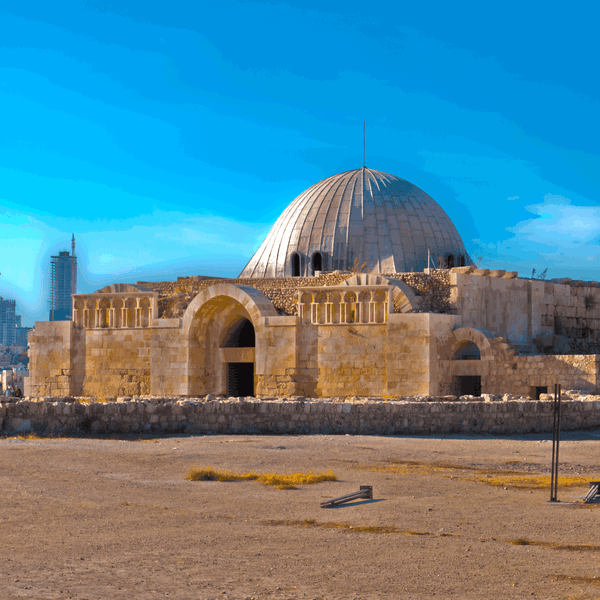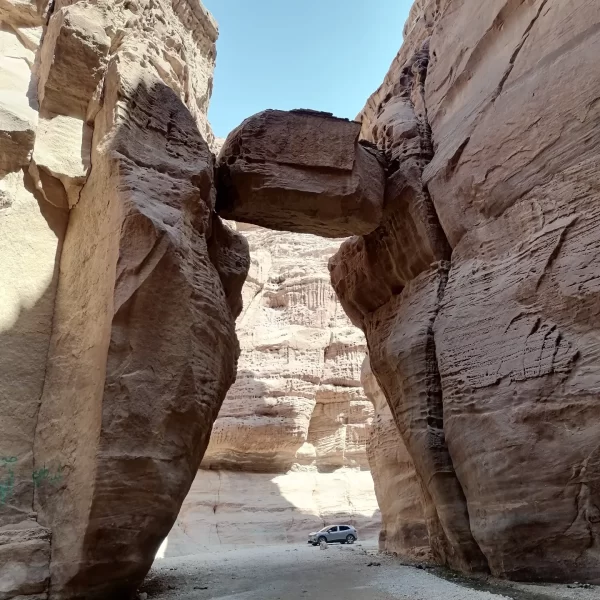AMMAN HISTORY
Throughout history, Amman has been inhabited by several civilizations. The first civilization on record is during the Neolithic period, around 6500 BC, when archaeological discoveries in ‘Ain Ghazal, located in eastern Amman, showed evidence of not only a settled life but also the growth of artistic work, which suggests that a well-developed civilization inhabited the city at that time. In the 13th century BC Amman was called Rabbath Ammon or Rabat Amon by the Ammonites (רַבַּת עַמּוֹן, Standard Hebrew Rabbat ʿAmmon, Tiberian Hebrew Rabbaṯ ʿAmmôn). It was later conquered by the Assyrians, followed by the Persians, and then the Greeks. Ptolemy II Philadelphus, the Hellenic ruler of Egypt, renamed it Philadelphia. The city became part of the Nabataean kingdom until AD 106 when Philadelphia came under Roman control and joined the Decapolis. In 324 AD, Christianity became the religion of the empire and Philadelphia became the seat of a bishopric during the beginning of the Byzantine era. One of the churches of this period can be seen on the city’s Citadel. Philadelphia was renamed Amman during the Ghassanian era, and flourished under the Caliphates (with nearby capital) of the Ummayads (in Damascus) and the Abbasids (in Baghdad). It was then destroyed by several earthquakes and natural disasters and remained a small village and a pile of ruins until the Circassians settlement in 1887. The tide changed when the Ottoman Sultan decided to build the Hejaz railway, linking Damascus and Medina, facilitating both the annual haj pilgrimage and permanent trade, putting Amman, a major station, back on the commercial map. In 1921, Abdullah I chose Amman as seat of government for his newly-created state, the Emirate of Transjordan, and later as the capital of the Hashemite Kingdom of Jordan. As there was no palatial building, he started his reign from the station, with his office in a train car. Amman remained a small city until 1948, when the population expanded considerably due to an influx of Palestinian refugees as a result of them leaving the newly-created state of Israel. Amman has experienced exceptionally rapid development since 1952 under the leadership of two Hashemite Kings, Hussein of Jordan and Abdullah II of Jordan. In 1970, Amman was the site of major clashes between the Syrian-backed PLO and the Jordanian army. Everything around the Royal Palace sustained heavy damage from shelling. Most of Amman suffered great damage from PLO rockets and Jordanian shells hitting suspected PLO buildings. The city’s population continues to expand at a dizzying pace (fueled by refugees escaping the wartime events in Palestine and Iraq). The city received refugees from these countries on a number of occasions. The first wave of Palestinian refugees arrived from West Bank and Gaza as well as Israel proper in 1948. A second wave after the Six Day War in 1967. A third wave of Palestinian and Jordanian and South East Asians, working as domestic servants, refugees arrived in Amman from Kuwait after the Gulf War of 1991. The first wave of Iraqi refugees settled in the city after the first Gulf War. A second wave also began arriving after the invasion and occupation of Iraq in 2003. During the last 10 years the amount of new building within the city has increased dramatically with new districts of the city being founded at a very rapid pace (particularly so in West Amman), straining the very scarce water supplies of Jordan as a whole, and exposing Amman to the hazards of rapid expansion in the absence of careful municipal planning.
Geography
Amman is located in a hilly area of north-western Jordan. The city was originally built on seven hills, but it now spans over an area of nineteen hills (each known as a jabal or “mountain”). The main areas of Amman gain their names from the hills and mountains on whose slopes they lie. Because of the cooling effects of its location on a plateau (a flat area of land), Amman enjoys four seasons of excellent weather as compared to other places in the region. Summer temperatures range from 28 – 35 degrees Celsius (82 – 95 °F), but with very low humidity and frequent breezes. Spring and fall temperatures are extremely pleasant and mild. The winter sees nighttime temperatures frequently near zero, and snow is known in Amman, as a matter of fact it usually snows a couple of times per year.The yearly average number of days with rain is 5-45 and with snow it is 0-8.It typically will not rain from April to September, with blue skies prevailing. But lately it started to rain in April and the beginning of May.
The city’s main airport, Queen Alia International Airport, is situated about 30 minutes south of Amman and hosts the majority of the air travel to and from the country. By land, the city has frequent bus connections to other cities in Jordan as well as to major cities in neighboring countries; the latter are also served by service taxis. Internal transport is served by a number of bus routes and taxis. Service taxis, which most often operate on fixed routes, are readily available and inexpensive. The main two bus and taxi stations are Abdali (near the King Abdullah Mosque, the Parliament and Palace of Justice) and Raghadan (near the Roman Amphetheatre in Downtown). The city can suffer from considerable traffic congestion at peak hours, especially during summer months when affluent vacationers from the Gulf region summer in Amman to take advantage of its relatively mild weather.
Is Amman, Jordan Worth Visiting: Amman, the capital city of Jordan, is definitely worth visiting. It offers a unique blend of history, culture, and modernity. Amman is famous for its historical sites, vibrant markets, delicious cuisine, and welcoming hospitality. Whether you’re interested in exploring ancient ruins, indulging in Middle Eastern cuisine, or experiencing the local culture, Amman has much to offer.
What Is Amman Famous For: Amman is famous for several reasons:
- Historical Sites: The city is home to ancient ruins, including the Roman Theater and the Amman Citadel, which provide glimpses into its rich history.
- Cultural Diversity: Amman is known for its diverse population and cultural scene, with art galleries, museums, and theaters that showcase the country’s artistic talents.
- Cuisine: Jordanian cuisine, with dishes like falafel, shawarma, and mansaf, is a highlight in Amman. The city is known for its food markets and delicious street food.
- Hospitality: Jordanians are known for their warm hospitality, and visitors often experience a warm welcome in Amman.
- Gateway to Jordan: Amman serves as the entry point for many travelers exploring other iconic Jordanian destinations, such as Petra, the Dead Sea, and Wadi Rum.
Is Amman the Oldest City in the World: Amman is one of the oldest continuously inhabited cities in the world, with a history dating back several millennia. However, it is not the absolute oldest city, as there are other ancient cities, such as Jericho in the West Bank, that claim an even longer history of continuous habitation.
What Should Female Tourists Wear in Jordan: Female tourists in Jordan should dress modestly out of respect for the local culture and customs. In more touristy areas like Amman, you can wear Western-style clothing like jeans and long-sleeve tops. However, when visiting religious sites or rural areas, it’s advisable to wear loose-fitting, long clothing that covers the arms and legs, as well as a headscarf. Additionally, it’s a good idea to carry a shawl or scarf that you can use to cover your head or shoulders when needed.
Is Amman Safe for Females: Amman is generally considered safe for female travelers. Jordan is known for its hospitality, and many tourists, including solo female travelers, have positive experiences. However, as with any destination, it’s essential to exercise common-sense safety precautions, such as staying aware of your surroundings, avoiding poorly lit or isolated areas at night, and taking care of your belongings.
Is It OK to Wear Shorts in Jordan: Wearing shorts is generally acceptable for tourists in Jordan, especially in more urban and touristy areas like Amman. However, it’s advisable to dress modestly when visiting religious sites and rural areas, as mentioned earlier. In conservative communities, it’s respectful to choose clothing that covers the knees and shoulders. Always be mindful of local customs and adjust your attire accordingly to show respect for the local culture.





